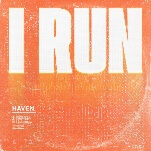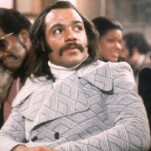In a way, every single episode of Riverdale is a gimmick episode. So when the show goes out of its way to create a very clear “gimmick episode” (for example, the Carrie: The Musical episode), it feels even more like an out-of-body experience than your standard, already pretty “out there” episode of Riverdale. But now this week’s episode, “Chapter Thirty-Nine: The Midnight Club,” takes that “out-of-body experience” concept almost literally, as it has its young cast play the teenage versions of its grown-up characters. It’s a high-concept episode that could just as easily bomb as much as the real-life Carrie musical—especially if it lives up to the ow expectations of this young cast playing dress-up more than the show itself actually giving them a story to work with—but instead, it ends up being one of the more impressive episodes of the series and the best of the season so far.
Obviously, Riverdale went with the IT inspirations in this season’s first couple of episodes, which included the parents suddenly having their own version of the Losers’ Club. (Here, 1992 FP Jones changes the “S” on his cast to make it perfectly clear that he’s no “LOSER,” he’s a “LOVER.”) But “Chapter Thirty-Nine” goes all-in on them also being their own version of The Breakfast Club, even bringing Anthony Michael Hall into the Archie-verse for the episode. However, in an inspired touch of Riverdale’s love for both pop culture and anachronisms, the show also decides to only play a 19980s music soundtrack to go along with an episode mostly set in the 1990s. After all, nothing smells more like teen spirit than Tears For Fears, right?
I’ve written a lot lately about how, at this point in Riverdale, the Archie role unfortunately does more of a disservice to KJ Apa as an actor (and even as a musician) than anything else. But here, while there is no check-in with Prison Archie, Apa actually gets to shine as the teenage version of Fred Andrews. It might even be Apa’s best work on the show (not counting his dancing in the musical), and it’s clear Apa is just scratching the surface on this role. A role that really is essentially 1992 (and 1990s, in general) Luke Perry, a very recognizable and specific figure to have to emulate when you’re an actor who was born in five years after the fact. But from the first moment he appears in this episode, Apa is doing his best Dylan McKay head tilts, only betraying the performance when it comes to the sideburn length.
The thing about this episode’s premise is that, in terms of nearly every adult member of the Midnight Club’s “core six” (Nathalie Boltt’s Penelope is the exception), Riverdale is in this strange situation where there are pretty easily-accessible records of what these characters would have actually looked like in the ‘90s. In fact, that is part of the appeal of the Riverdale parental casting in the first place. So while Apa does a surprisingly good Perry performance despite not having all the tools of the actual ‘90s Perry—I was not a Dylan McKay fan, but I admit he had a certain dreaminess—on the opposite end of the spectrum is Ashleigh Murray, who has quite the uphill battle to fight when it comes to playing a 1992 Sierra McCoy (née Samuels). When it comes to pretty much playing a 1992 Robin Givens. (For reference, see: Boomerang.) And unlike Apa, Riverdale doesn’t allow her to also fall back on an attempt to look more like her counterpart.
Lili Reinhart—who shoulders the bulk of the episode’s work and crushes her very non-Betty performance—isn’t an exact copy of a ‘90s era Mädchen Amick either. But the way she carries herself as 1992 Alice Cooper (née Smith), she’s able to sell it even more than any intense resemblance could. Just pay attention to when the episode goes from a shot of 1992 Alice to the present day Cooper household: Reinhart plays the former with all the confidence in the world (even if it’s faux confidence, especially as she keeps her pregnancy secret), while the latter clearly lacks the same commanding presence. In fact, despite Betty’s typical crime-solving resolve, she slouches like the most unconfident of teens, never as willing as Alice (either version) to let the world know she’s not to be messed with. Meanwhile, Cole Sprouse gets by in this episode on the perfectly-placed hair of a Scream-era Skeet Ulrich (that is strangely contained in his first scene as FP but ends getting better with every passing scene) and the gum-chewing swagger of a modern-day FP Jones. And when 1992 FP goes on about how he won’t hit his son like his father hits him, Sprouse momentarily captures that desperation Ulrich often does whenever FP’s able to call Jughead “boy” or take a drink we all know he shouldn’t. “Big Man On Campus” FP isn’t exactly modern, worn down FP, but the flashes are there.
Like Ashleigh Murray, Camila Mendes has somewhat of a challenge channeling a ‘90s era Marisol Nichols… but it quickly becomes clear that it’s not so much that she couldn’t channel her TV mother’s ‘90s look and style, as it is this particular version of Hermione wouldn’t be recognizable as a ‘90s era Nichols either. The rebellious Catholic backstory for Hermione—as well as her maid mother who disapproved of “petty criminal” Hiram—is a much-needed backstory to help balance the conflicting versions we saw of the character in season two.
While most of the 1992 versions of these characters are recognizable (at least in terms of their characterization and what drives them), when it comes to their 2018 versions—even without in-jokes like Sierra’s lack of desire to become Mayor of Riverdale—the one character in this extended flashback whose journey is difficult to parse until all the pieces are in play is Penelope Blossom. It’s arguably the iffiest part of this episode—not counting the glaring lack of a young Mary Andrews, especially given the episode’s Hughesian framing device—as while Madelaine Petsch does a good job as this 1992 character, the idea of calling her a “1992 Penelope” feels inaccurate for so much of it. (When she asked, “Haven’t you seen Heathers?” all I could think is that there’s no way the 1992 Penelope we’ve seen so far would have. Or she at least missed the point entirely.) Because this flashback fills in a lot of “point A to point B” blanks regarding character progression from those often talked about teen years until now, it’s understandable if point A doesn’t take a completely straight line to get to point B. But until Alice voiceovers about how the death of Principal Featherhead (Anthony Michael Hall, of course) and the craziness of Gryphons & Gargoyles led to “the game master [becoming] the pawn,” Penelope’s humanity (especially her revelation as a Blossom prisoner with Stockholm Syndrome) and her try-hard nature looks foreign to the absolute villain we know as present day Penelope Blossom. The conclusion to Penelope’s story here certainly sticks the landing, but it’s also one that will clearly play better on rewatch, especially as one of the biggest tragedies (if not the biggest) of this flashback’s depiction of the Midnight Club’s end of innocence.
However, there’s an argument to be made that Penelope is perhaps the only adult character on Riverdale who has yet to be a “pawn” at any point—as even in her losing battles to Cheryl, she never came across as weak in that way. While 1992 Penelope giving into her “family’s” wishes is clearly her defense mechanism as a very scared girl post-Midnight Club, to call her a “pawn” is to ignore how she turned this awful situation into power for herself. On the “plus” side, this backstory frames Penelope’s lady of the night and brothel aspirations much better than season two’s “back to Blossom family basics” excuse, as it then makes sense as a profession that allows her to be a woman in control. She’s back to being the game master. (It also frames her decision to send Cheryl to Sisters of Quiet Mercy—a place Penelope lived until she was eight—as even more horrific. And Sierra as a really bad former mayor, as even as a teenager, she knew that place violated “every humanitarian code.” Riverdale would probably be better off never mentioning the place again, as every character looks worse the longer it goes on unchecked.)
Perhaps the best choice Riverdale makes early in this episode is having Jughead’s voiceover mention how G&G offered the teens “an escape from [their] nightmarish reality.” This is the driving force behind the Midnight Club’s bonding too, and as cartoonish—this is really all just a live-action comic book being taken to even more ridiculous extremes like a drug called “Fizzle Rocks” anyway—as the idea of a D&D rip-off “epidemic” hitting everyone in Riverdale High is, it makes enough sense to just accept it and see where the nerdy version of reefer madness takes us. As Mayor Hermione says, these teenagers have “impressionable, developing minds,” and that’s the case both in 2018 and 1992. In fact, an integral component to both of these time frames, other than just actors’ physical similarities to other actors, is Riverdale remembering to highlight the fact that these are kids and that they’re all just behaving as such, only to a heightened degree. (Yes, even a “kid detective” still counts as acting like a kid. Just ask Lauren Lapkus and Thomas Middleditch.) As many times in my notes as I wrote that everyone in this town is a nerd of the highest order, it’s difficult to deny the genuine, infectious joy that comes from seeing all of the Midnight Club dressed up in their G&G costumes and just playing, fully immersed in the game and ready to have an Ascension Party. Like with Ethel when she’s in full-on Princess Etheline mode, in 1992, all these kids were really just trying their best. They even say as much: To the Midnight Club, G&G was a much-needed temporary distraction and escape from the fact that their home lives were unsatisfying.
Of course, in 2018 Riverdale, their entire town lives are unsatisfying. So it really makes sense why even Jughead, Cheryl, and the rest of the lamest gang ever would want to lose themselves in G&G at the end of the episode. It’s also a terrific tonal shift to end this episode, with Betty witnessing a rarely seen out of control, crazy-eyed Jughead talking about his plans for “ascension.”
Then there’s the best scene of the episode, which I spent about three seconds dreading: the musical number. I’ve mentioned how Riverdale has seemingly learned the wrong lessons from Glee, and upon seeing “The Fred Heads,”it looked like the episode’s otherwise great momentum would be halted. But then something crazy happened, as the musical number combined the ‘90s power of the Zack Attack (even more than the Saved By The Bell-inspired title card, as the number looks 100% like a Zack Attack performance at first) with the obvious horror inspirations of both A Nightmare On Elm Street (specifically, as the song points out, A Nightmare On Elm Street 3: Dream Warriors) and Twin Peaks. This is on top of what might be the funniest reference (and joke, which is something Riverdale doesn’t usually so much do as it embodies) of the series, when it’s revealed that 1992 FP said he lived on Elm Street… a reference to young Skeet unfairly being called a “poor man’s Johnny Depp.” It also means that Alice moved on with Hal Cooper and moved into what could’ve been FP’s literal dream home. Ouch. And while I noted Reinhart isn’t exactly a young Amick doppelganger, she reaches her full Amick potential when the musical number has her play the sober 1992 Alice as intensely aware of just how lame her friends are right now and when it features her as the star of her own mini-Twin Peaks (with Dawn Wilkinson’s direction of this demented party literally transforming Reinhart into Amick as much as it possibly can).
While this episode obviously works for the bigger picture of the Gargoyle King story and as a welcome character study for the show’s adult characters, it also works as an instantly rewatchable, “standalone” episode in a way that a lot of Riverdale episodes really don’t. The big gimmick episodes like this are really perfect for that, but “Chapter Thirty-Nine” is perhaps the most integral of the bunch (which include “Chapter Twenty: Tales From The Darkside” and “Chapter Thirty-One”). This episode’s issues—all tied to minor backstory continuity problems Riverdale has to ignore to tell this story—aren’t large enough to take away from the episode, and in terms of intent, this episode truly continues season’s three impressive hot streak and keeps the mystery interesting.
Stray observations
- The Bones Zone (Retro Edition): R.I.P. Fred’s father and Principal Featherhead.
- Josie and the Keller-cat: Funnily enough, Sierra McCoy and Tom Keller get some of the best stuff out of all this point A to point B character study. When we first got confirmation about Sierra/Tom’s affair back in season two, I wondered if the show would attempt to tackle the racial situation. After all, it was an affair between the black mayor (and we knew Riverdale wasn’t all that progressive) and a white sheriff. For this episode to include the backstory—their parents didn’t want them to date because of race—it makes their already somewhat sympathetic affair even more so. So Ashleigh Murray and Casey Cott get a compelling story when they’re not playing Josie and Kevin. Got it. Seriously: The actual “Kevin” scene is just Cott regurgitating some plot hand-waving. “FYI, I’m only there after school.” Yes, that explains how a teen will spend his time somehow overseeing a “24-hour crisis hotline” for all things G&G (especially when it provides information for Betty’s investigation), but it does not explain why a teen should be overseeing a “24-hour crisis hotline” for something that is dangerous enough to ban, instead of a… therapist? (Do those even actually exist in Riverdale?) Saved By The Bell did two teen line episodes, so it’s on brand for this episode.
- Outside of the “core six,” our 1992 Hiram arguably doesn’t have to do much of anything to make the transformation work, as Riverdale just cheats and has mini-Mark Consuelos—his and Kelly Ripa’s son, Michael Consuelos—play him. And Casey Cott doesn’t so much have to look like a young Martin Cummins—he does not—as he just has to be as stealthily jacked as his character’s father—which he is.
- Alice: “It was junior year. Phones had cords, Winona had Johnny, and everything smelled like teen spirit.” This is Riverdale—phones still have cords.
- I thought I’d made a “Teenage Suicide (Don’t Do It)” joke for this season so far, but apparently, I did not. And apparently, Riverdale was prepared.
- Veronica thinks she’ll make “Fibes’ 20 Under 20” list. It’s nice to have dreams.
- 1992 Fred (about 1992 Hiram): “Dude is ripped.” This was the one moment in Tessa Leigh Williams’ script that took me out of the episode. If Riverdale is going for a commentary on the homoeroticism of jock culture, then maybe it’s good. But considering most of Riverdale’s slo-mo buff “teen” boy shots (I’m not sure if it’s surpassed Teen Wolf levels yet), any actual commentary was thrown out the window a long time ago.
- I’m curious about how Riverdale has walked back the Blossom incest stuff, especially after teasing it so much in season one (and then ultimately making it Jason/Polly). Now Penelope isn’t even biologically a Blossom. But I guess most of the town thinks she is?
- In what might count as a Chilling Adventures of Sabrina Easter Egg, there’s a flyer for a Bulldogs vs. Ravens football game in the Riverdale High common room. Also, how long until I can mention the mild spoiler of a character who made it to the Bones Zone here showing up on CAOS (and making it to the Bones Zone again)?
- Tommy: “Daryl Doiley found it in the restricted section of the library.” The Doileys have always been creeps.
- Reggie’s dad was #33, just like Tim Riggins.
- Remember when Penelope stroked Archie’s face and hair? In 1992, she was all about doing that to Fred when they were tripping, so it’s just something she does.
- Daryl Doiley does the splits when he’s high. He’s better than his son, Dilton “I Just Stabbed My Leg!” Doiley.
- Since the 1992 bathroom ends up covered in lipstick, I guess Attorney McCoy is the murderer/Gargoyle King (we saw 1992 Sierra with the lipstick on the mirror). Mystery solved! It’s interesting the show’s not suggesting Alice just had a Betty-like hallucination about that part, isn’t it?
- Biggest missed opportunity? The lack of a scream queen moment once Featherhead’s dead body appears.
- While Riverdale has yet to make Archie’s struggles with sports vs. music interesting, it’s able to do that with Fred in one episode. First, it reveals 1992 Fred never actually struggled between either; he planned to do both before he gave up that dream for the family business. Also, unlike Archie, in just one scene, the episode shows just how focused and driven Fred was: While the others give him crap for not wanting to go further than this town, not only did he have a plan that proved a fulfilling life was possible in Riverdale, he had a plan for how he was going to give back to the town.
- The lack of Hal frustrated me, until the reveal that all this led to Alice moving on to him and her path toward becoming “Alice Cooper.” She definitely picked the wrong mark to have a malt at Pop’s with though.








































